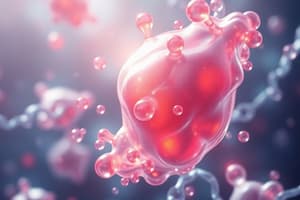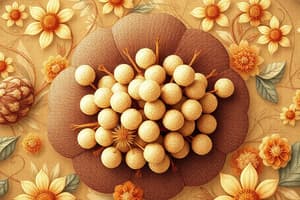Podcast
Questions and Answers
Which characteristic is shared by all lipids?
Which characteristic is shared by all lipids?
- Composed of amino acids
- Hydrophobic nature (correct)
- Solubility in water
- Presence of hydrophilic functional groups
What is the primary role of triglycerides in the body?
What is the primary role of triglycerides in the body?
- Building blocks for muscle tissue.
- Insulation of nerves enhancing conductivity.
- Quick source of energy only used in emergencies.
- Long-term energy storage. (correct)
A scientist isolates a fat molecule that is solid at room temperature and primarily from an animal source. Which type of lipid is most likely present?
A scientist isolates a fat molecule that is solid at room temperature and primarily from an animal source. Which type of lipid is most likely present?
- Phospholipid
- Oil
- Unsaturated Fat
- Saturated Fat (correct)
What structural feature characterizes an unsaturated fatty acid?
What structural feature characterizes an unsaturated fatty acid?
A biochemist is analyzing a series of unknown lipids. One lipid is found to have a high degree of unsaturation and is liquid at room temperature, while another is solid at room temperature and is found to have the maximum possible number of hydrogen atoms. Mass spectrometry confirms both lipids have roughly the same molecular weight. Which of the following statements must be true?
A biochemist is analyzing a series of unknown lipids. One lipid is found to have a high degree of unsaturation and is liquid at room temperature, while another is solid at room temperature and is found to have the maximum possible number of hydrogen atoms. Mass spectrometry confirms both lipids have roughly the same molecular weight. Which of the following statements must be true?
What structural feature defines a saturated fatty acid?
What structural feature defines a saturated fatty acid?
Trans fats are used in food products for what primary purpose?
Trans fats are used in food products for what primary purpose?
Why are omega-3 fatty acids classified as essential fatty acids?
Why are omega-3 fatty acids classified as essential fatty acids?
How do phospholipids arrange themselves in an aqueous solution, such as within a cell?
How do phospholipids arrange themselves in an aqueous solution, such as within a cell?
If a newly synthesized steroid molecule is found to have an atypical functional group attached to its four-ring carbon skeleton, what is the MOST likely effect this will have?
If a newly synthesized steroid molecule is found to have an atypical functional group attached to its four-ring carbon skeleton, what is the MOST likely effect this will have?
Which of the following is NOT a primary function of proteins within cells?
Which of the following is NOT a primary function of proteins within cells?
What type of bond links amino acids together to form a polypeptide?
What type of bond links amino acids together to form a polypeptide?
How do different amino acids vary from one another?
How do different amino acids vary from one another?
A protein is composed of one or more polypeptide chains folded into a specific 3D structure. What determines the precise function of a protein?
A protein is composed of one or more polypeptide chains folded into a specific 3D structure. What determines the precise function of a protein?
Imagine a newly discovered organism synthesizes a protein with unusual properties. After analysis, it's found this protein contains only 15 different amino acids, and one of these amino acids (let's call it 'X') is a synthetic, non-standard amino acid with a highly reactive side chain capable of forming disulfide bridges with multiple other 'X' residues within the same polypeptide. How would the presence of amino acid 'X' MOST likely influence the protein's structure and stability, compared to a standard protein?
Imagine a newly discovered organism synthesizes a protein with unusual properties. After analysis, it's found this protein contains only 15 different amino acids, and one of these amino acids (let's call it 'X') is a synthetic, non-standard amino acid with a highly reactive side chain capable of forming disulfide bridges with multiple other 'X' residues within the same polypeptide. How would the presence of amino acid 'X' MOST likely influence the protein's structure and stability, compared to a standard protein?
Which characteristic is common to monosaccharides?
Which characteristic is common to monosaccharides?
What is the primary difference between starch and cellulose?
What is the primary difference between starch and cellulose?
Which disaccharide is formed from the bonding of glucose and fructose subunits?
Which disaccharide is formed from the bonding of glucose and fructose subunits?
During beer production, yeast breaks down maltose into glucose, utilizing the glucose as an energy source. What process also occurs at this time?
During beer production, yeast breaks down maltose into glucose, utilizing the glucose as an energy source. What process also occurs at this time?
A researcher is studying a newly discovered polysaccharide in a plant. Initial tests show it's composed entirely of glucose monomers but is indigestible by both animals and microorganisms. However, after treating it with a novel enzyme, the polysaccharide becomes digestible by certain microorganisms. Which structural feature is most likely present in the original polysaccharide that explains its initial indigestibility?
A researcher is studying a newly discovered polysaccharide in a plant. Initial tests show it's composed entirely of glucose monomers but is indigestible by both animals and microorganisms. However, after treating it with a novel enzyme, the polysaccharide becomes digestible by certain microorganisms. Which structural feature is most likely present in the original polysaccharide that explains its initial indigestibility?
Flashcards
Monosaccharides
Monosaccharides
Single sugar molecules; the simplest form of carbohydrates.
Disaccharides
Disaccharides
Two monosaccharides joined together by a chemical bond.
Polysaccharides
Polysaccharides
Long chains of monosaccharides bonded together; complex carbohydrates.
Sucrose
Sucrose
Signup and view all the flashcards
Starch
Starch
Signup and view all the flashcards
Lipids
Lipids
Signup and view all the flashcards
Triglycerides
Triglycerides
Signup and view all the flashcards
Fats
Fats
Signup and view all the flashcards
Oils
Oils
Signup and view all the flashcards
Fatty Acids
Fatty Acids
Signup and view all the flashcards
Saturated Fatty Acids
Saturated Fatty Acids
Signup and view all the flashcards
Phospholipids
Phospholipids
Signup and view all the flashcards
Polar Head
Polar Head
Signup and view all the flashcards
Nonpolar Tails
Nonpolar Tails
Signup and view all the flashcards
Steroids
Steroids
Signup and view all the flashcards
Proteins
Proteins
Signup and view all the flashcards
Keratin
Keratin
Signup and view all the flashcards
Enzymes
Enzymes
Signup and view all the flashcards
Amino Acids
Amino Acids
Signup and view all the flashcards
Polypeptide
Polypeptide
Signup and view all the flashcards
Study Notes
- Contains carbon and hydrogen atoms; examples include biomolecules or biological molecules
- Lacks a combination of carbon and hydrogen atoms; examples include water(H2O) and table salt (NaCl)
Carbon Atoms
- Almost always share electrons with elements like hydrogen, nitrogen, and oxygen
- Typically bond with as many as four other elements
- Often share electrons with other carbon atoms to form carbon chains
- Chains of carbon atoms that bond only to hydrogen atoms, which can form branches and ring compounds, are hydrocarbons
- Isomers are molecules with the same chemical formula but different structures
- Isomers have different functions because structure determines function
Carbon Skeleton and Functional Groups
- An organic molecule's shape is determined by its carbon chain, called the skeleton or backbone
- The reactivity of an organic molecule is determined by the attached functional groups
- A functional group has the same chemical properties and reacts in the same way, no matter the carbon skeleton to which it is attached
- Functional groups determine chemical properties, like water solubility, and the chemical reactions of organic molecules
- Types of Functional Groups include Hydroxyl (Alcohols, Sugars), Carboxyl (Amino acids, Fatty acids), Amino (Amino acids, Proteins), Sulfhydryl (Amino acid cysteine, proteins), and Phosphate (ATP, nucleic acids)
Biological Molecules
- Four categories exist: carbohydrates, lipids, proteins, and nucleic acids
- They break down into subunits to build the macromolecules that make up the body during digestion
Complex Biological Molecules
- Monomers are subunits
- Polymers are monomers joined together
- A dehydration synthesis reaction joins monomers to form polymers by removing a water molecule
- A hydrolysis reaction is where an OH group attaches to one monomer and H from water attaches to the other monomer, used to break bonds in a polymer
Carbohydrates
- Almost universally used as an immediate energy source in living organisms
- Provide structural functions for plants and fungi
- Also called saccharides, and exist as monomers or polymers
Types of Carbohydrates
- Monosaccharides are a single sugar like molecule
- Disaccharides are where two sugars molecules are bonded
- Polysaccharides are many sugars bonded together
Carbohydrates – Monosaccharides
- Simple sugars
- Have a carbon backbone consisting of three to seven atoms
- Water soluble because of many polar OH functional groups
- Form ringlike structures in a water environment
- Glucose (C6H12O6) has 2 isomers, fructose and galactose
- Cells use glucose as the immediate energy source
- Ribose (C5H10O5) and deoxyribose (C5H10O4) exist in RNA and DNA
Carbohydrates - Disaccharides
- Two monosaccharides bonded together
- Maltose is made up of 2 glucose subunits; yeast breaks down maltose during beer production, uses the glucose as an energy source, and produces ethyl alcohol during fermentation
- Sucrose (table sugar) consists of glucose and fructose subunits
- Lactose (sugar in milk) consists of glucose and galactose subunits
- Lactose intolerance is not being able to break down lactose; symptoms include abdominal pain, gas, bloating, and diarrhea
Carbohydrates- Polysaccharides
- Polymers of monosaccharides, usually glucose
- Plants store glucose as starch
- Animals store glucose as glycogen
- Cellulose is a component of plant cell walls
- The most abundant of all carbohydrates
- Made up of glucose subunits joined by different bonds than those in starch and glycogen
- Cannot be digested by animals; only by some microorganisms
- An important dietary fiber component
Lipids
- All are hydrophobic and insoluble in water
- Possess long, nonpolar hydrocarbon chains and a relative lack of hydrophilic functional groups
- They have very diverse structures and functions, with 4 major groups: triglycerides (fats and oils), phospholipids, and steroids
Lipids-Triglycerides: Fats and Oils
- Made up of one glycerol molecule and three fatty acids
- Main constituents of body fat in humans, animals, and vegetable fat
- Can be solid or liquid at room temperature, depending on structure and composition
- The body's primary long term energy storage molecule
- Fats are solid at room temperature; typically exist in animals, and provide energy, insulation, and protection of internal organs; dietary sources include lard, butter, cheese, and meats
- Oils are liquid at room temperature, typically from plants and some fish; dietary sources include olive oil and corn oil
Fatty Acids
- The primary component of fats and oils; most cells contain 16-18 carbon atoms per molecule, though some have smaller or larger amounts
- Can be saturated or unsaturated
- Unsaturated has double bonds in the carbon chain wherever the number of hydrogens is less than two per carbon atom
- Saturated has no double bonds between the carbon atoms (hence, the carbon chain is saturated with hydrogen atoms
- Saturation or unsaturation determines a fatty acid’s chemical and physical properties
Lipids-Phospholipids
- Made up of glycerol + 2 fatty acids + phosphate group + polar functional group (R)
- Has a hydrophilic end (polar head) and a hydrophobic end (nonpolar tail)
- Form bilayers where heads project outward and tails are inward
- Compose the bulk of the cell membrane
Lipids-Steroids
- Derived from cholesterol
- Cholesterol is an important component of animal cell membranes
- Have a carbon skeleton composed of 4 fused/adjacent rings
- Differ in functional groups attached to the carbon skeleton, which determines their effects on the body
- Insoluble in water
Proteins
- Have structural and functional roles in cells: examples include support (keratin, collagen), metabolism (enzymes), transport (channel and carrier proteins), defense (antibodies), regulation (hormones), and movement (actin and myosin)
- Cell structure and function differ according to the types of proteins they contain
Proteins-Amino Acids
- The building blocks of proteins
- Consist of a central carbon bonded to a hydrogen atom, amino group, carboxyl group, and a side chain or R group
- 20 different amino acids exist, which change their properties with their R groups
- Chemical properties of an amino acid depend on the chemical property of the R group
Proteins-Peptides
- A peptide consists of two or more amino acids linked by a covalent bond, called a peptide bond
- A peptide bond forms from a dehydration synthesis reaction consisting of two amino acid monomers
- A polypeptide is a chain of many amino acids joined by peptide bonds
- A protein can contain one or more polypeptide chains
- Amino acid sequence determines three-dimensional shape and hence its function
Shape of Proteins
- Proteins have multiple levels of structure
Protein Structures
- Primary: amino acid sequence
- Proteins are composed of amino acid chains that form helices in one portion of the chain, or pleated sheets in another
- Secondary: portions of the amino acid chain form helices or pleated sheets through hydrogen bonds made by nearby peptide bond
- Tertiary: the overall three-dimensional shape determined by interactions between the R groups of the amino acids within the polypeptide
- Quaternary: more than one polypeptide chain interacting
- Proteins can be classified by fibrous or globular shape, typically the overall shape and the tertiary or quaternary structure
- Fibrous have a rodlike shape and have structural roles, like keratin or collagen
- Globular have a rounded or irregular shape and examples are enzymes and hemoglobin
Problems
- Protein Denaturation: proteins lose their native conformation (shape) due to disruptions in non-covalent and covalent bonds, resulting in loss of biological activity
- Protein Denaturation Causes: high temperatures, pH changes, chemical agents, and mechanical forces
Nucleic Acids
- Deoxyribonucleic acid (DNA) stores genetic information
- Ribonucleic acid (RNA) helps to make proteins
- Polymers of nucleotide monomers
Nucleotides
- composed of a phosphate, a 5-carbon sugar, and a nitrogen-containing base
- 2 types of sugar: deoxyribose in DNA and ribose in RNA
- Five types of bases—adenine (A), guanine (G), cytosine (C), and thymine (T) [DNA only], Uracil (U) [RNA only]
Nucleic Acids-Structure of DNA
- Double helix
- The backbone has alternating phosphates and sugars nitrogenous bases project inward from the backbone
- Two strands of DNA held together by complementary base pairing
- Adenine (A) pairs with Thymine (T)
- Cytosine (C) pairs with Guanine (G)
- Base sequence along the DNA strand encodes genetic information
Nucleic Acids- Structure of RNA
- Single-stranded
- Contains ribose sugar
- Uses uracil (U) instead of thymine (T)
- Plays an important role in translating the genetic information in DNA into proteins, facilitating biological processes
Relationship Between Proteins and Nucleic Acids
- Base sequence in DNA determines amino acids sequence in a protein
- Amino acid sequence in a protein determines the protein's shape, which influences the functions of the protein
- Types of proteins within cells define its structure and function
- Small changes in the DNA may cause large changes in a protein
- Individual's red blood cells are sickle-shaped because of sickle-cell disease, with one amino acid difference, as an inherited disease
Studying That Suits You
Use AI to generate personalized quizzes and flashcards to suit your learning preferences.




